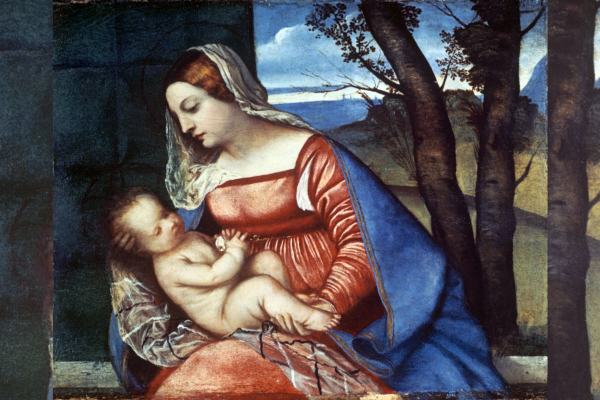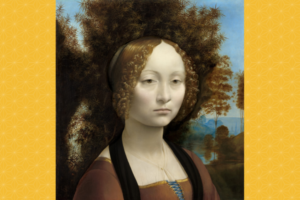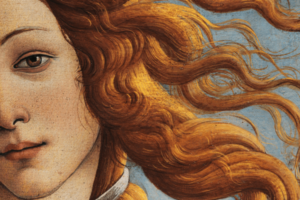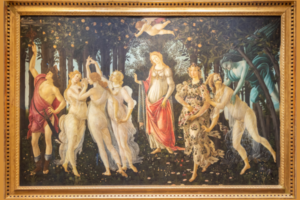The Renaissance, a term derived from the French word for “rebirth,” is a period that spanned the 14th to the 17th century, marking a profound transformation in European art, culture, politics, and science. This era was characterized by a revival of classical learning and values, where artists and scholars looked back to Greco-Roman antiquity for inspiration. It was a time when the human spirit sought to break free from the confines of the Medieval mindset, with a renewed focus on individualism, creativity, and a fierce curiosity about the natural world.
Amidst the throng of influential figures that emerged during this epoch, one name shines brightly, both for his mastery of technique and his pioneering use of color: Titian, or Tiziano Vecellio in his native Italian. Born in the small town of Pieve di Cadore, nestled in the Dolomite mountains, Titian would eventually find his way to Venice, the bustling hub of art and trade. Here, in the shimmering city of canals, he would craft some of the most iconic artworks the world has ever seen.
To say that Titian was merely a painter would be an understatement. He was a visionary, an artist who pushed the boundaries of what was possible with a brush and palette. While many of his contemporaries were still bound by the rigid techniques of the past, Titian embraced freedom in his strokes, playing with light, shadow, and most notably, vibrant colors. His contribution to Renaissance painting was not just in the images he created, but in how he made people feel when they gazed upon them, immersing viewers in a world of emotion, passion, and unparalleled beauty.
As we delve into the luminous world of Titian’s artistry, we will discover how he came to epitomize the vibrant colors of Renaissance painting, leaving a legacy that would inspire generations of artists to come.
The Early Life of Titian
In the mountainous regions of northeastern Italy, surrounded by the breathtaking landscapes of the Dolomites, lies the small town of Pieve di Cadore. It was in this serene setting, in the late 1480s, that Titian, or Tiziano Vecellio, first opened his eyes to the world. The sceneries of Pieve di Cadore, with its dramatic play of light and shadow upon the mountains, undoubtedly sowed the initial seeds of inspiration in the young artist’s mind.
While Titian’s precise date of birth remains a subject of debate, his early years in Pieve di Cadore shaped his formative experiences. The Vecellio family was of modest means, but they recognized the budding talent in young Titian and were keen on nurturing it. His initial instruction in the arts might have come from local masters, but the real metamorphosis of Titian from an enthusiastic novice to a master-in-the-making occurred when he left his hometown for the dazzling city of Venice.
Venice in the late 15th and early 16th centuries was a nexus of art, culture, and commerce. The city was teeming with artists from various parts of Italy and Europe, each bringing their unique style and techniques. It was here that Titian began his formal training, entering the renowned workshop of the Bellini brothers. Giovanni Bellini, the elder of the two, was at the time the leading artist in Venice. Under the meticulous guidance of the Bellinis, Titian honed his skills, absorbing the prevailing Byzantine influences while also being exposed to the emerging trends of the High Renaissance.
The Bellini workshop was not just a place for learning traditional techniques. It was a melting pot of ideas and innovations. Here, Titian encountered Giorgione, another prodigious talent of the time. Their close association and mutual influence are evident in their early works, blurring the lines for historians and art enthusiasts trying to differentiate between the two.
In the midst of this vibrant artistic environment, Titian began to develop his distinctive style. While he was deeply influenced by the Bellinis and Giorgione, he was never one to merely imitate. Even as a young apprentice, Titian’s inclination towards bolder colors and innovative techniques began to manifest, signaling the birth of an artistic genius.
As we trace the trajectory of Titian’s illustrious career, it becomes evident that the confluence of his serene upbringing in Pieve di Cadore and the dynamic tutelage in Venice played a pivotal role. The mountains gave him a sense of wonder, and Venice offered him the tools to express it, setting the stage for the masterpieces that were yet to come.
Titian’s Pioneering Use of Color
In the vast tableau of the Renaissance, where numerous artists etched their names with impeccable skill and innovation, Titian’s mastery of color set him apart. His paintings are symphonies of hues, where each color plays its part, be it a soft whisper of a background tone or the bold proclamation of a central figure.
The Evolution of His Color Palette
In Titian’s early works, one can discern the strong influence of his mentors, the Bellini brothers, and his close association with Giorgione. These initial pieces often carried the earthy tones typical of Venetian traditions – muted browns, deep greens, and rich blues. However, as Titian matured as an artist, a transformation occurred. His palette became more diverse and adventurous. He began to introduce radiant reds, glowing golds, and other warm colors that gave his paintings a sense of depth and life. This transition was not abrupt but a gradual exploration, reflecting his growing confidence and desire to communicate more profound emotions through his art.
Breaking Away from Traditional Methods
The traditional approach to painting during the Renaissance often involved carefully planned layers, with each layer serving a specific purpose. While Titian was trained in these methods, his genius lay in how he adapted and transcended them. Instead of just layering colors, Titian blended them, allowing for a more natural transition between tones and creating a luminosity that was almost ethereal.
Furthermore, he was not just content with the pigments available. Historical accounts suggest that Titian experimented with mixing his pigments, seeking out new materials and even consulting with alchemists to achieve the vibrant colors he envisioned.
Techniques Behind the Richness
Titian’s mastery was not merely in choosing the right colors but in how he applied them. One of the techniques he frequently employed was the “velatura” method. This involved applying thin, semi-transparent layers of paint over a dried layer underneath. This technique allowed him to modulate colors, create soft transitions, and achieve a rich depth that gave his paintings a three-dimensional feel.
Another distinctive feature of Titian’s work was his use of “cangiante” technique, where he would use a different color, rather than just a darker or lighter shade, to depict the play of light and shadow. This method gave his figures a radiant quality, making them appear almost illuminated from within.
The brushwork in Titian’s later works became looser, which when combined with his bold color choices, resulted in an almost impressionistic quality. This was revolutionary for his time, as it showcased not just the subject of the painting, but the raw emotion and energy behind each brushstroke.
Titian’s use of color is not just about the hues on the canvas but the emotions they evoke. Through his pioneering techniques and bold explorations, he created artworks that were not mere representations but vivid, breathing entities. His departure from traditional methods and his embrace of luminosity and vibrancy set a precedent in the art world, forever changing the way we perceive and experience color in art.
Iconic Works and Their Color Significance
Titian’s illustrious career spanned several decades, and in that time, he produced a plethora of masterpieces that captivated audiences then and continue to do so today. While his entire oeuvre is deserving of admiration, a few pieces stand out, especially when discussing his innovative use of color. These paintings serve as milestones, marking Titian’s journey as a colorist par excellence.
The Assumption of the Virgin
Housed in the Basilica di Santa Maria Gloriosa dei Frari in Venice, “The Assumption of the Virgin” is a monumental work, both in size and impact. Here, Titian portrays the moment the Virgin Mary ascends to Heaven, surrounded by a host of angels.
At first glance, the viewer is immediately drawn to the vibrant reds of Mary’s robe, which contrasts sharply with the serene blue skies above and the earthy tones below. This choice of red not only accentuates the Virgin’s centrality in the composition but also symbolizes her divine love and sacrifice. The golden hues around her, especially the angels enveloping her in their embrace, further accentuate the sanctity and celestial nature of the event. Titian’s use of these colors not only captures the spiritual essence of the scene but also brings a palpable energy and dynamism to the canvas.
Venus of Urbino
In “Venus of Urbino”, we see Titian venturing into the realm of the sensual and intimate. The painting, which depicts the Roman goddess of love in a reclining pose, is a masterclass in the portrayal of skin tones.
Titian’s Venus has a soft, luminous skin that radiates warmth, achieved through the delicate layering of peach, pink, and creamy tones. This radiant skin contrasts beautifully with the rich, dark drapery behind her and the deep red of the cushions on which she reclines. The contrasting colors not only draw attention to Venus herself but also emphasize her sensuality and the luxurious surroundings. The softness of her form juxtaposed against the vibrant hues encapsulates the essence of beauty and desire.
Diana and Actaeon
“Diana and Actaeon” is a narrative piece, telling the story of the unfortunate hunter Actaeon who stumbles upon the goddess Diana bathing. Here, Titian’s use of color transcends mere aesthetics; it becomes a tool for storytelling.
The canvas is a cascade of colors, each chosen to depict a specific emotion and movement. Diana’s shock at being discovered is emphasized by the cool, pale blues and whites of her form and the water around her. In contrast, Actaeon’s imminent transformation into a stag and his impending doom are signaled by the warmer tones – the rich browns of his attire and the deep greens of the forest. The myriad of colors used for the nymphs, caught in various states of surprise and action, further add to the drama and chaos of the scene.
Titian’s art is a visual feast, where each color, whether boldly proclaimed or subtly whispered, serves a purpose. Through pieces like “The Assumption of the Virgin”, “Venus of Urbino”, and “Diana and Actaeon”, we see not just the artist’s evolution in terms of technique, but also his profound understanding of the emotional depth colors can convey. It’s this synergy of skill and emotion that makes Titian’s works timeless and iconic.
Titian’s Influence on Future Artists
Just as the ripples from a single stone can spread far and wide across a pond, the influence of a great artist can span centuries and inspire countless others. Such has been the case with Titian. His innovative approach to color, combined with his technical prowess and emotional depth, has left an indelible mark on the world of art, with echoes of his legacy seen in the works of many who followed.
The Legacy of Titian’s Color Techniques
Titian’s mastery of “velatura”, his fearless experimentation with pigments, and his revolutionary approach to light and shadow didn’t just make him a standout artist of the Renaissance; it set a new standard for the use of color in art. His nuanced layering techniques, the luminous glow he achieved in his depictions, and his bold color choices became a benchmark, a point of study, and a source of inspiration for future generations.
Rubens: A Dance of Colors
Peter Paul Rubens, the Flemish Baroque painter, is often heralded as one of the artists profoundly influenced by Titian. Rubens’ paintings are known for their vivacity, drama, and, notably, their vibrant use of color. His energetic compositions were imbued with a richness of tone reminiscent of Titian. One can see the inspiration drawn from Titian in the way Rubens painted skin, drapery, and dynamic scenes, using color not just as a visual element but as an emotive force.
Velázquez: The Spanish Titian
Diego Velázquez, one of Spain’s most celebrated painters, was so profoundly influenced by Titian that he was often referred to as the “Spanish Titian.” Velázquez’s trip to Italy exposed him to Titian’s masterpieces firsthand. This experience left a lasting impact on his style. While Velázquez maintained a distinct individuality, the depth and luminosity he achieved in works like “Las Meninas” or his various royal portraits echo Titian’s treatment of light, shadow, and, of course, color.
Rembrandt: Chiaroscuro and Beyond
While Rembrandt’s art is often associated with his mastery of chiaroscuro – the play of light and dark – his approach to color, especially in his later works, exhibits the depth and warmth that can be traced back to Titian. The layered textures, the glowing skin tones, and the emotional intensity achieved through color in paintings like “The Jewish Bride” are testimonies to Titian’s lingering influence.
Art is a continuum, where each artist, while forging their unique path, stands on the shoulders of giants who came before them. Titian’s influence on the realm of color is undeniable, resonating through the ages in the works of many great masters. By studying and embracing his techniques, artists like Rubens, Velázquez, and Rembrandt not only paid homage to Titian’s genius but also ensured that his legacy of color would continue to inspire for centuries to come.
The Vibrant Colors as a Reflection of Renaissance Ideals
The Renaissance, a word that translates to “rebirth,” was an era marked by a renewed interest in the knowledge of antiquity and a blossoming of arts and sciences. It was not just a period of rediscovery but also of reinterpretation and innovation. Just as philosophers and writers sought to explore the depths of human existence, painters used color to delve into the very essence of life and emotion. In this vibrant tapestry of the Renaissance, color was not merely an aesthetic choice; it became a medium of profound expression, intricately linked with the ideals of the era.
Rebirth and Radiance
The very notion of rebirth brings with it images of vibrancy, freshness, and the bursting forth of new life. The dark, subdued palette of the medieval period gave way to the rich, luminous colors of the Renaissance. Artists, inspired by this idea of rebirth, sought to capture the vibrancy of life in their works. The radiant blues, deep reds, and glowing golds were not just colors but symbols of a world reawakening to the wonders of existence.
Humanism and Emotional Depth
Humanism, one of the cornerstones of the Renaissance, placed humanity and individual experience at its core. This emphasis on the human experience was mirrored in art. Artists like Titian did not merely paint figures; they breathed life into them using color. Each hue was carefully chosen to convey emotions, from the passionate reds representing love and anger to the somber blues and greys reflecting melancholy. In this era, a portrait was not just a representation of a person but a window into their soul, made vivid by the deliberate play of colors.
Nature’s Palette and the Natural World
With the Renaissance came a renewed interest in the natural world. Artists began to study nature meticulously, striving to reproduce its myriad colors on canvas. This was not just an exercise in realism but also a reflection of the Renaissance ideal of harmonizing with nature. The lush greens of landscapes, the subtle variations in skin tones, and the play of light and shadow were all attempts to capture the beauty and intricacies of the natural world. The vibrant colors of nature were seen as a manifestation of the divine, and by replicating them, artists were, in essence, paying homage to the Creator.
Beyond Aesthetics: Stories and Symbolism
In the hands of Renaissance masters, colors became storytellers. Each painting was a narrative, where colors conveyed deeper meanings, allegories, and symbols. For instance, the Virgin Mary was often draped in blue, symbolizing purity, while martyrs were depicted in red to represent their sacrifice. The careful selection and juxtaposition of colors could convey complex stories, moral lessons, or philosophical musings, making each artwork a tapestry of meanings.
In the Renaissance, color became more than just a visual delight; it transformed into a powerful tool of expression, capturing the ideals, aspirations, and emotions of an era. The vibrant colors of this period, epitomized by artists like Titian, are a testament to the Renaissance’s rich legacy of exploration, innovation, and deep reverence for both the human experience and the world at large.
The Shift in Perception of Color in the Renaissance
The progression from the Medieval period to the Renaissance heralded more than just new techniques and innovative artistic expressions. It represented a profound metamorphosis in the way color was perceived and employed in art. Titian’s work, with its mesmerizing interplay of vibrant hues, epitomizes this transformation. To appreciate his genius fully, it’s essential to understand the broader shifts that swept through the artistic world of the Renaissance.
From the Shadows of the Medieval Period
The Medieval art, while profoundly spiritual and symbolic, was often characterized by a more muted palette. Colors in these works were frequently flat, with minimal shading or depth, reflecting the era’s primary focus on conveying religious messages rather than portraying realistic depth or human emotion. This isn’t to say Medieval art lacked sophistication; its beauty lay in its iconic representations and its spiritual symbolism.
Dawning of a New Age
The Renaissance was a period of enlightenment and rediscovery. As Europe emerged from the shadows of the Middle Ages, there was a renewed interest in the knowledge of the ancient Greeks and Romans. This revival wasn’t just intellectual but extended to art. Inspired by the naturalism of the ancient world and equipped with new techniques and materials, artists began to explore the potential of color in ways previously unimagined.
The Discovery of Depth and Perspective
One of the most revolutionary advancements of the Renaissance was the mastery of perspective. Artists no longer painted figures as flat, two-dimensional entities but endowed them with depth and volume. Color played an integral role in this. By employing chiaroscuro (the contrast of light and dark) and sfumato (the soft blending of tones), artists like Titian could create a three-dimensional illusion on a flat canvas. This shift towards depth and realism was made possible through the nuanced use of shades, tints, and tones.
The Emotional Power of Color
While the Medieval period used color primarily for symbolism, the Renaissance artists recognized its potential to evoke emotions. Titian and his contemporaries understood that a well-placed stroke of crimson could convey passion, while a deep blue could immerse a viewer in introspection. The dynamic use of color became an essential tool for artists to communicate not just stories but the emotional depth behind them.
The Broader Palette of the Renaissance
Technological advancements in pigment creation and the increasing global interactions also expanded the available color palette. Artists had access to brighter, more durable, and varied pigments, allowing for a richness and vibrancy previously unattainable. This expanded palette, combined with the innovative techniques of the time, gave birth to the iconic masterpieces of the Renaissance.
Titian’s vibrant canvases can be viewed as the culmination of a broader transformation in the world of art. The Renaissance, with its renewed approach to color, moved away from the static and symbolic representations of the Middle Ages to a dynamic, emotional, and deeply human portrayal of the world. Through artists like Titian, color became not just a component of art but its very soul, capturing the essence of an era that forever changed the landscape of artistic expression.
Conclusion
As we journey through the vibrant tapestry of the Renaissance and delve into the luminous world of Titian, it becomes evident that art is not merely a reflection of its time but a powerful force that shapes perception, culture, and history. Titian, with his masterful use of color and groundbreaking techniques, stands as a towering figure in this transformative epoch, leaving an indelible mark on the realm of art.
Titian’s Undying Impact
Titian’s influence extends far beyond the confines of the 16th century. His fearless experimentation with color, combined with his ability to convey profound emotion, laid the groundwork for generations of artists. His techniques, from layering to his treatment of light, have become foundational in the world of painting. But more than just technique, Titian gifted the art world with a renewed vision of what color could achieve — a medium to connect with the very soul of the viewer.
The Everlasting Echoes of the Renaissance
The Renaissance, as an era of rebirth and innovation, has left an enduring legacy that resonates even today. This was a period where art, science, literature, and philosophy converged, leading to monumental shifts in human thought and expression. The vibrant hues and emotional depth of Renaissance paintings have become emblematic of this golden age, serving as a constant reminder of humanity’s boundless potential and insatiable curiosity.
In modern painting, the footprints of the Renaissance are unmistakable. Whether it’s in the way artists approach light and shadow, the depth of emotion conveyed on canvas, or the boldness with which they experiment, the guiding principles of the Renaissance remain deeply embedded. Contemporary artists, even while pushing the boundaries of expression, often find themselves revisiting and paying homage to the techniques and visions of Renaissance masters like Titian.
In Retrospect
Art, in its myriad forms, has always been a mirror to society, reflecting its aspirations, struggles, and evolution. Through figures like Titian, we gain insights not just into the techniques of painting but into the zeitgeist of an era. His vibrant colors, more than mere pigments on canvas, are a celebration of life, human emotion, and the eternal quest for beauty and meaning. As we stand on the cusp of new artistic horizons, the legacy of Titian and the Renaissance serves as both an inspiration and a beacon, guiding us towards new expressions and explorations.



